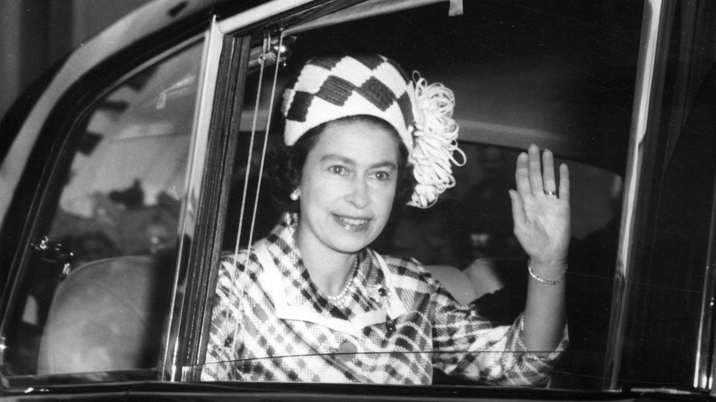
Finding the words
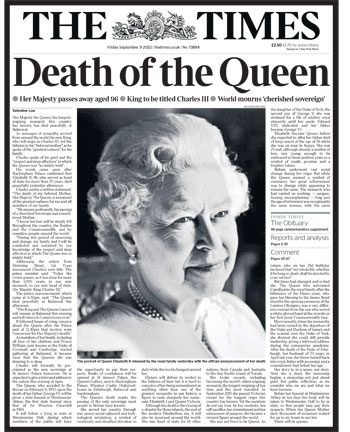
“How to find the words…” mused Sarah Vine in the opening sentence of the Mail’s coverage of the Queen’s death. Vine and fellow journalists seemed to manage, producing hundreds of thousands of them over the past week. Many of them very good indeed.
This was the event our trade had been rehearsing for decades, “The Queen is dead” the metaphorical headline for the biggest story imaginable. When it came to it, of course, the headline was redundant, since everybody already knew by the time the papers hit the newsstands on Friday. But The Times stepped up to the paper-of-record plate with “Death of the Queen” on a text-heavy black and white page. This seemed exactly right, conveying the message: “This is an historic moment; we are the paper to document history; we will tell you about what happened and what will happen as a result.” Whether the words beneath the headline and the pages and pages that followed lived up to that implied promise is a matter of opinion, but the tone was pitch perfect.
That mattered because “How to find the tone…” was the bigger challenge than Vine’s quest for vocabulary. A nation that had three months ago delighted in the Queen taking tea with Paddington Bear had to come to terms with the fact that it would never see her again; that it would have a king. Suddenly, after 70 years, broadcasters were talking about “Queen Elizabeth” because “the Queen” was no longer the woman in a headscarf who liked horses and corgis, but “good sort” Camilla, the “third person” in that ill-fated Wales marriage.
The warning signs had been there: the prolonged absences from public view, the outgoing and incoming prime ministers’ flights to Balmoral, the cancellation of a Zoom Privy Council meeting. When you’re not fit enough for a video meeting, you’re probably quite unwell. The final photograph with Liz Truss added to the concern: the thin face, the bruised hand. But she was still smiling, her eyes bright; this didn’t look like a woman at death’s door. And so the end came as a shock.
The passing of notes during the energy crisis statement in the Commons, the unusual statement on the Queen’s health from the Palace, the emergence of Huw Edwards in dark suit and black tie in the middle of the day, all gave newspapers a few hours’ head start and they made good use of it. Every single one rose to the occasion – and not just the nationals.
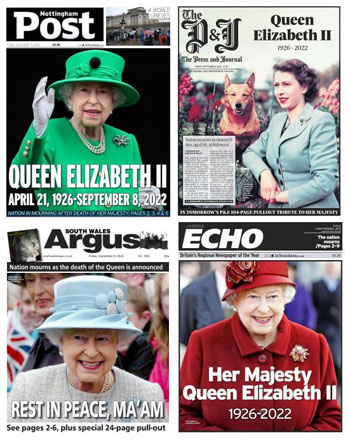
My little local daily, which must be put together these days by a couple of seniors, a junior and a three-legged dog, produced the usual paper plus a 28-page supplement. The front-page photograph was the Queen on a visit to the town some years ago; an approach adopted by many others in the regional Press, including the Nottingham Post, Liverpool Echo, Aberdeen Press and Journal and South Wales Argus. Good call.
For all newspapers, great and small, there were two key decisions to be made: the picture and the splash headline. Yes, that’s the case every day, but it had never mattered so much. Or had it? You could say that it had never mattered so little, since whichever photograph and whatever the form of words, the paper would sell out (I did a tour of a dozen supermarkets, newsagents, petrol stations on Friday and there wasn’t a newspaper of any title to be had anywhere – hurrah! for our industry). But of course it mattered. Professional pride meant everyone wanted to do their best and be the best – and you can be sure that on Friday morning, every newsroom will have been full of people proclaiming that their paper had smashed it out of the park and beaten their rivals hollow.
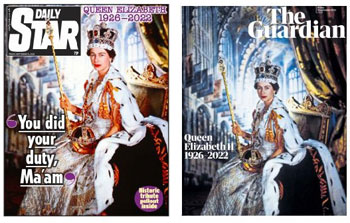
So back to those pictures and headlines. I mentioned The Times earlier, but that history-laden monochrome front wasn’t the one people saw on the newsstands. That was hidden inside a wraparound with a full-colour Coronation portrait with the legend “A life in service”. It wouldn’t have been my choice of picture, but what do I know – because the Star, the i and the Guardian all agreed with The Times. Similarly, the Sun, Telegraph and Express all used the Jane Bown portrait from 2006 that was on the Times’s “real” front page. This was the picture released by the Palace to announce the death, so was in a way the “easy” option. The Mirror went with a profile that was evocative of the image we have in our minds from stamps and coins – except she was facing the other way. The Mail, Metro and FT all went for an image from her younger days, demonstrating the perennial obit dilemma of whether to use an illustration from the subject’s prime or as they were most familiar to readers.
As to the words, I think the most sensible editors were those who just went with the classiest front-page convention for notable deaths, which is name and dates – in this case “Queen Elizabeth II 1926-2022”. That is what the FT, Metro and Guardian did and they looked all the better for it. The Telegraph’s quote from the Queen after 9/11, “Grief is the price we pay for love”, worked, as did the Mirror’s simple “Thank you”. The Express’s “Our beloved Queen is dead” felt right for its audience. But “We loved you Ma’am” (the Sun), “You did your duty Ma’am” (Star) and “Our hearts are broken” (Mail) jarred for me – maybe because they made this death about us, not the Queen.
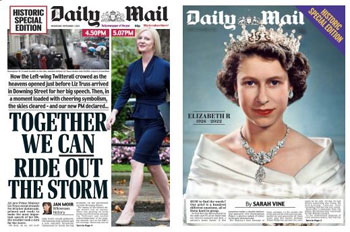
Hovering in carping corner for a moment in a column that is intended to celebrate an amazing performance by journalists over the past week, I would say that the i front was a little cluttered and the Mail cover was disappointing for a title that can usually be relied upon to come up with the most arresting front – even when you disagree with its message. Here I couldn’t suppress a flash of schadenfreude over its tag “historic special edition”. Only two days earlier, it had proclaimed its coverage of Liz Truss becoming PM in exactly the same form of words. You may recall, I questioned that then. I think my scepticism was vindicated on Friday.
Sustaining the coverage
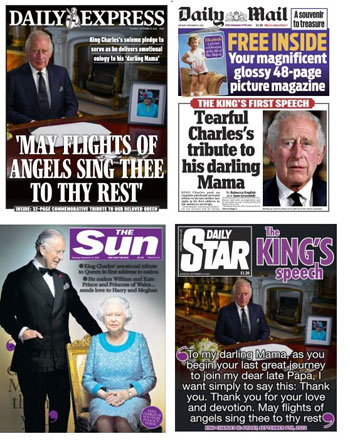
Back to the question of tone. Royal coverage in some papers has always been sycophantic and obsequious, so there were real dangers here. If you’re in the habit of using superlatives to describe Kate wearing a dress or holding a child’s hand, there will be the difficulty identified by Vine in finding the right words to capture the essence of a 70-year reign. There was also the peril of descending into mawkishness and over-sentimentality, as exemplified after the death of Diana a quarter of a century earlier. For the most part, these pitfalls were avoided – for the first day or so at least. The ardent royalist papers could be forgiven, I think, for laying it on thick on day one, when there was so much to say: about her life and about her death, about what had happened over the past seven decades and what would happen in the following seven days. The one thing everyone could be confident of on Thursday was that there would be an insatiable appetite for everything they could shoehorn into Friday’s paper – and the chances were that readers shared their world view of “The Firm”.
Even the more sceptical papers understood this, and did not stint, while retaining a sense of seriousness and perspective rather than emotion.
But could this be sustained over ten days of mourning? There’s only so much treacle even the man with the sweetest tooth can stand. The Mail gave us 83 news pages of the Queen on Friday, another 48 on Saturday, and was still managing 29 on Monday (not to mention the 48-page glossy magazine and the special supplement on Sunday); the Mirror started off with 35 pages and was down to 21 by Monday. The Express had a comparatively modest 31 pages on Friday, but perhaps thought it had undercooked the story, since it was up to 39 the next day. In common with the Mail, it was still turning out 20-plus pages by yesterday.
Metro has been notable in the volume of its coverage. It tends not to give more than a single spread to stories that go on for ages in other titles, but it gave over its entire edition to the Queen on Friday, starting with a front and back that had to be turned on its side to produce a poster, and had eight pages yesterday. Only the Guardian and Star have yet pushed the story back in the book. This morning, a week on, the tally of news and comment pages is: Mail 38; Express 26; Mirror 18; i and Sun 17; Times 15; Telegraph 14; Metro 11; Guardian 10; Star 5 and FT 2.
Not all of this is complimentary – today’s Guardian leads its Journal section with Aditya Chakrabortty on, “It’s one rule for our billionaire king, another for the rest of us” – but the bulk of it is pro-royal.
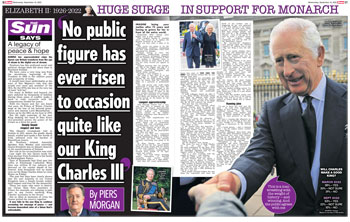
With such a mass of copy, the descent to cliché and slush was probably inevitable – just as the public appetite must be waning. People have lives to lead, they are going to work and school, they are still worried about how they’re going to pay the heating bill. “Even the sky was weeping” (the Sun) might have been ok on Thursday, but yesterday? Come on, give it a rest. In the same paper, Piers Morgan opined that “No public figure has ever risen to the occasion quite like our King Charles III”. Really? Camilla Tominey in the Telegraph was also wide of the mark on Saturday with “Heartfelt speech was most personal ever delivered by a monarch”.
The republican question
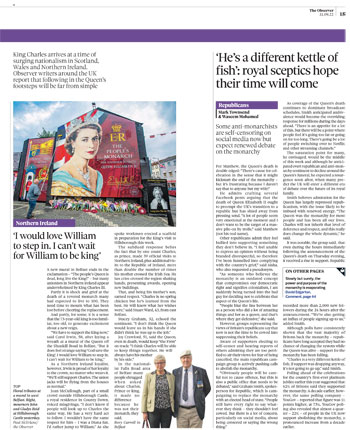
We have had a seamless transition from one sovereign to another, but there are those who feel we should not have done, that the monarchy is an anachronism and that this is the moment to get rid of it. This is not a majority view, but it is one that is growing. A YouGov poll taken before the jubilee found that 62% supported the monarchy – down 11 points on a decade earlier – but also that 22% thought it should be abolished.
A week after the Queen’s death would probably be judged as “too soon” by most to raise such questions, but if not now, when? When Charles dies? There has to be a “moment” when the debate is allowed to take place – even if the conclusion is that we are fine where we are, that the Royal Family are good for the country in a number of ways and don’t actually cost it that much money in the grand scheme of things.
It has been interesting to see how this issue has been broached (if at all) by the various papers. Rumblings about the Commonwealth and mutterings from some of its members, notably Australia, about not having a king as head of state have made back-of-the-run page leads in the past couple of days, but there has been a reticence about republicanism here at home. The Observer had a good piece on how republicans were self-censoring on social media out of fear, the message being “they think their time may be coming, but just not this minute”.
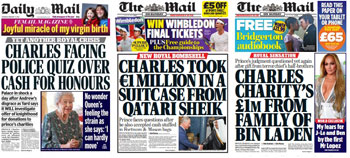
That piece noted that Charles’s popularity was in doubt. It has certainly been up and down over the years. He’s on the up at the moment, but it’s only six weeks since he was being embarrassed over links with a relative of Osama bin Laden, ten since he was accused of accepting wads of cash stuffed into suitcases and Fortnum and Mason bags from a Qatari sheikh, and seven months since he was embroiled in a “cash for honours” and “cash for citizenship” inquiry. Then there’s all the backdrop of spidery letters to politicians. He said in an interview that he wasn’t “so stupid” as not to realise that he would have to rein back on expressing his opinions once he was busy reigning. But we’re not so stupid that we don’t know what he thinks.
The transition of (ceremonial if not actual) power might have been seamless, but we’re not moving from like to like, and newspapers would be foolish to pretend that we are. Affection for the Queen, both at home and abroad, was very largely based on perceptions of her personality and character; an appreciation of how she fulfilled her position, not a result of the position itself.
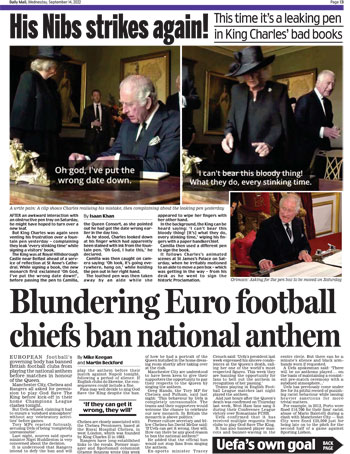
We have already seen the difference with the King’s tetchiness over a misplaced inkwell and a leaky pen, occasions where he allowed his irritation to show in a way we would not have expected from his mother. It’s easy to understand and possibly excuse, given the extraordinary pressure, physically and psychologically, that he has been under – more than many a man half his age could cope with – but those incidents could have been a glimpse of the real man behind the promises of duty and service.
It is possible that you don’t have a clue what I’m talking about here. Videos and pictures of his gritted teeth and under-the-breath mutterings went viral on social media, but went unreported by most newspapers. Hats off, then, to the Mail, which covered both – and with the less-than-reverential head “His nibs” on the leaky pen.
Free speech
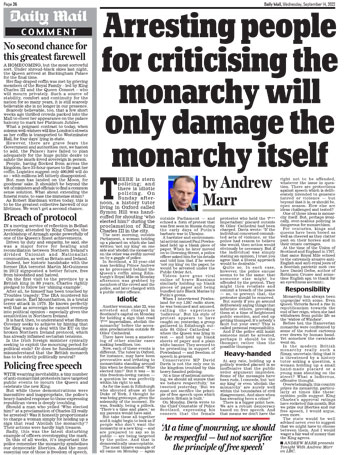
The Mail has also done well in questioning the treatment of people who have dared to protest about the King’s accession. A leader yesterday was less than sympathetic to their cause, but said that the right to free speech was paramount. It was consistent with its approach to the free press and its own right to be obnoxious, but was refreshing to see at a time when the “woke” are constantly being told to shut up and when Priti Patel’s new policing laws seem to want to shut down any dissent from the right-thinking view. Yesterday’s paper also had a page lead on “over-zealous” policing and an oped by Andrew Marr headlined “Arresting people for criticising the monarchy will only damage the monarchy itself”. No 10 has also come out in defence of people’s right to protest. It’s taken a few days since many of us were first disquieted by the official response to a bit of placard-waving, but they got there in the end.
Dissenting voices
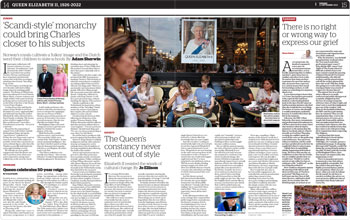
There is, of course, no “right” way to respond to the death of the Queen – even if the reams of newsprint might suggest that grief and respect are obligatory. Some of the postings on social media have been cruel - notably that from an American university professor who hoped that her pain would be excruciating - and reminiscent of the “Ding, dong, the witch is dead” response to the demise of Margaret Thatcher. Even those who might have joined in the latter realise that the Queen is a different kettle of fish. She may have lived a life of unrivalled privilege, but it wasn’t one that she chose and she apparently sought to do good in the role assigned to her. She could have abdicated, but that would have gone against everything that she had learnt from the aftermath of her uncle’s renunciation of the throne. And it wouldn’t have changed “the system”. Thatcher, on the other hand, made a considered decision to go into politics and her politics had a direct influence on people’s lives, with many blaming her for their hardships.
This difference seems to have escaped the fish and chip shop owner who videoed herself celebrating the Queen’s death with champagne. Her business is unlikely to recover.
I don’t think that celebrating anyone’s death (well, there maybe the odd exception in Russia) is a good move, but nor should we be required to don widow’s weeds and weep and wail. The expectation that we should feel and act in a certain way is, however, implied in the hyper-extensive news coverage and it has led to some very strange responses – with Morrison’s silencing its self-checkout scanner bleeps the oddest. The BBC cancelling Last Night of the Proms, rail and postal workers calling off their strikes, the Premier League postponing games while the Test match went ahead were all knee-jerk reactions that might have borne a second thought. Simon Kelner in the i wrote a particularly good piece about this on Tuesday, saying that fears of transgressing arbitrary lines of what’s right and what’s wrong had led to judgment going out of the window: “And what do the football authorities, the BBC and the trade unions have in common? They are all organisations that, even in the normal course of events, get a rough ride from public opinion. You can understand their not wanting to take chances, but this has resulted in odd decisions that have more to do with protecting their reputations than respecting Her Majesty.”
Quite. For “public opinion” read “the Daily Mail”. The very paper that is, paradoxically, now defending the right to transgress those arbitrary lines.
Center Parcs’ U-turn
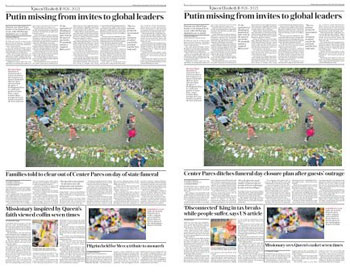
Another unthought-out reaction was the Center Parcs announcement that it was closing everywhere on Monday. What were holidaymakers who had travelled hundreds of miles supposed to do? Go home for a day? “Families’ anger as Center Parcs shuts” said The Times, but after the “shock and anger” in the intro and quotes from disgruntled holiday makers in the next few pars, it reported: “Last night the company changed its decision…” So why the intro and heading? Yes, it started out as a “what the hell…?” story, but the company saw the error of its ways and so the story changed.
The Telegraph recognised this, going between editions from “Families told to clear out…” to “Center Parcs ditches closure plan after guests’ outrage”. The Star went from “Center Parcs axes holidays” to “Parcs U-turn rescues hols”, the Mail had it doing a U-turn.
So back to the Times. It had the change of heart in its first edition report – probably as a last-minute insert. But why not redo the whole thing, more honestly, for the second as others did?
In other news
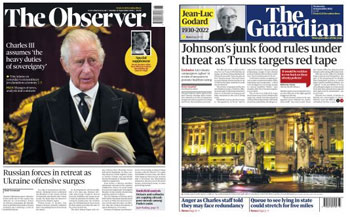
The Observer was the first paper not to splash on the Queen’s death, with Ukraine taking the main headline (under a huge royal picture) on Sunday. Its sister the Guardian has followed suit this week, in line not only with what it probably perceives as its readers’ outlook, but also in line with disinterested news values. The Ukrainian advances and the hopes and fears they arouse are, to my mind, the big story of this week. The Queen was humungous and obviously top of every agenda on Thursday and Friday; it was bound to continue to be so for most titles in the following days, but I’m concerned that other issues with wider ramifications are being buried under the weight of ceremonial.
I’m not sure that Johnson’s junk food rules being under threat was the best splash the Guardian could have come up with yesterday or that banning the filling of swimming pools and the sale of a Lowry painting were the sort of subjects I’d have preferred for pages 2 and 3 over the arrangements for the lying-in-state and funeral. But the paper clearly recognised that its audience hungered for something different.
The obverse of that coin was the Mirror’s first page lead after the royalty: “Vlad nuke fear” doesn’t read like a page 17 headline to me. The old rule applies: if it’s true, it’s too far back; if it’s not true, it shouldn’t be there.
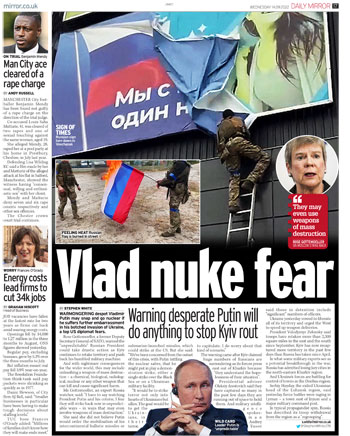
Four days lying in state? Rethink needed
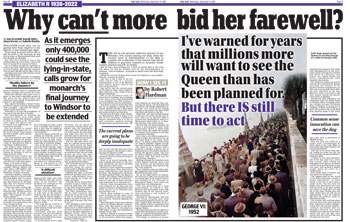
I knew I’d been a babe in arms among the throng lining the Mall for the Coronation, but I learnt on Friday that I was also in the crowd for George VI’s lying in state. Albeit in utero. “Just realised Mum must have been three months pregnant,” messaged my sister. “We survived on rich tea and chocolate biscuits.” Well, I never knew. She also recalled in another message that she, our mother and our sister – then aged 9 – had queued all day and crossed the Thames over Lambeth and London bridges several times. “Given that it is now easier for people to travel into London than it was, will a week lying in state be enough?” Then she came back again with “Only 4 days!!!”
My daughter agreed. “They’ll have to move the funeral to Friday,” she pronounced, with more than a hint of self-interest, since Monday is her birthday and she wanted to go out to dinner to celebrate.
Well, they won’t change it now, I said. But I share my family’s misgivings. Looking at the crowds already around Buckingham Palace, it is inconceivable that – even with all the dire warnings about having to stand and keep moving for 30 hours – only the predicted 400,000 will want to file past the coffin in Westminster Hall. There are likely to be a lot of frustrated people. And a lot of frustrated people in a whirlpool of emotion don’t make for easy policing.
The Mail has reached the same conclusion, but instead of just accepting that that’s the way it’s got to be, published an essay by Robert Hardman yesterday suggesting ways that plans could be altered to give more people a chance to pay their respects. I’m not holding my breath, but the authorities did realise during the Diana outpourings that their strategies were not going to work, so maybe there’ll be some tweaks this time.
It seems the 400,000 estimate was based on being double the turnout for the Queen Mother. I’m not a huge royalist, but I am nosey. So when she died in 2002, I wandered down to Westminster at the end of a shift at 3am to get a sense of the occasion. There was no queue, so I just walked into Westminster Hall. Well you would, wouldn’t you? I doubt anybody will be doing that this week. A similar curiosity had taken me to Buckingham Palace after the late shift the night before Diana’s funeral. There were a lot of very emotional people there and a lot of flowers in front of the gates – though there were millions more outside Kensington Palace. And so, it was a no-brainer to take a peek on Saturday after a wicket-abundant day at the Oval. The atmosphere this time was far more sombre and quiet. And there were far more barriers than I remember for Diana – my memory may be playing tricks, but I recall walking freely around the Palace and the Victoria Memorial in a way we couldn’t this time. On Saturday, we had a look at some flowers that had been left in the formal beds still sporting their red, blue and white jubilee plantings, but ducked away from the chest-to-back queue being funnelled round to Green Park, where most of the flowers had been laid out. That was ten days before the funeral; there are thousands more people there now and there will be tens of thousands more to come. I don’t think the powers-that-be have got this quite right.
If they haven’t, the press will be the first to conduct an inquest into who did the planning and how they got it wrong. Much better to take the Mail approach and try to put it right in advance.
Questions that need answering
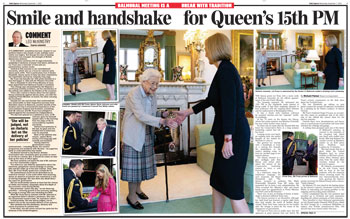
With so many angles to cover and such a volume of work falling on ever-reducing staff complements, it’s no surprise that so many papers find themselves regurgitating the official handouts without proper analysis and detailed questioning. The logistics of the funeral planning are one thing, but what about the last days and death of the Queen herself? We saw how frail she had become. We can see the decline in her health from the pre-covid days, through her lockdown address, to that final Liz Truss picture. “Mobility issues” doesn’t begin to cover it. There has been mild conjecture about the bruise on her hand, but no one has dared ask what was wrong with her. We don’t even know when she died. The Sunday Telegraph told us that Truss was aware before she went into the Commons on Thursday that the Queen was very ill. We also know that the Prime Minister was formally advised of her death at 4.30. Was the Queen still alive when those notes were passed around the front benches, when that health bulletin was issued?
The Palace has been fobbing off people with legitimate queries for years, and would doubtless decline to answer these sorts of questions. But why aren’t they being asked? I’m not encouraging speculation on the part of the Press, but I do think that papers like the Times or the Telegraph could legitimately pose them in their leader columns. They won’t, of course, because the suspicion is that they were complicit; that they knew well before the rest of us that she was dead. Guido Fawkes announced the death at around 3pm, then retracted.
Questioned by Press Gazette, no editor was willing to elucidate. It’s one thing to respect an embargo, but to maintain the secrecy – or feign ignorance – after the event is unnecessarily deceitful and smacks of omerta, of being in thrall to the Palace for fear of being denied access in the future.
The time and cause of death of a sovereign should not be kept from the public, and if such information is not being volunteered by those who know, it is the Press’s duty to demand it – not conceal it – on behalf of her people.
I am told (I haven’t checked, sorry) that the Duke of Edinburgh’s death certificate has “old age” as the cause. It would be wrong were such euphemism allowed in the case of the Queen.
And finally…
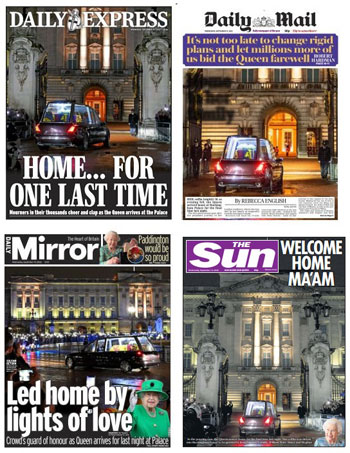
Yesterday’s front pages caused a raised eyebrow as they were almost all a variation on the theme of “homecoming”. We have had a week of papers telling us how much Balmoral was the Queen’s favourite retreat, how Windsor was her favourite home, how she “escaped” to Sandringham for Christmas. Buckingham Palace was her official residence and place of work. Those headlines struck me as the equivalent of describing someone being driven from hospital to the office as “going home”.
But here are some random things I liked:
This last sentence from Valentine Low’s Times splash on Friday.

This headline in the Telegraph.
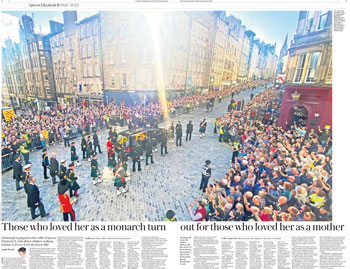
The symmetry of this Sun wraparound.
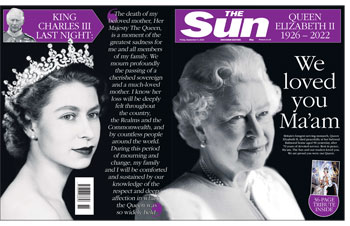
And front page of the week: This deviation from the norm; classy, dignified and a stunning picture to boot.
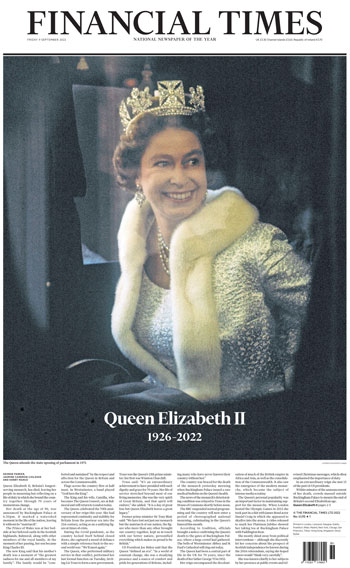
Liz Gerard’s Notebook is a fortnightly column published in the InPubWeekly newsletter. To be added to the mailing list, enter your email address here.












